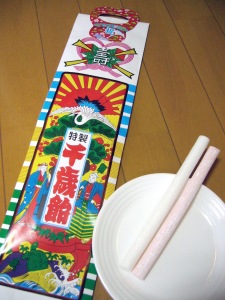
Shichi-Go-San: A Japanese Birthday Celebration
Shichi-Go-San literally means 7-5-3 in Japanese. The festival, held every November 15, is a traditional rite of passage for Japanese boys turning 3 and 5, and girls turning 3 and 7 years old. It celebrates the growth and happiness of young children.
Children get dressed in traditional clothing and attend a special ceremony at a shrine. Girls wear kimonos. The younger girls usually wear hifu (a type of padded vest) with their kimono. The older girls wear the obi (a traditional, elegant sash), for the first time. Boys dress in haori (a traditional Japanese coat) and hakama (traditional leg-wear worn for the first time). Recently, many children are wearing Western-style dresses and suits instead. 
Following the ceremony, families take photographs and children receive a special type of candy called Chitose Ame.  The “thousand year candy” is a pair of white and pink sticks (the colors of good luck) and symbolizes health, growth, and a long life. The candy comes in a paper bag with images of a crane and a turtle (symbols of longevity) and images of pine trees and bamboo (symbols of good luck).
The “thousand year candy” is a pair of white and pink sticks (the colors of good luck) and symbolizes health, growth, and a long life. The candy comes in a paper bag with images of a crane and a turtle (symbols of longevity) and images of pine trees and bamboo (symbols of good luck).


There are some different explanations for the ages chosen. These odd numbers are considered lucky, according to Japanese numerology; these were traditionally the ages that children were given a kimono; and traditionally children were expected to have their heads shaven until the age of three and this was a day to celebrate the day a child could begin to grow their hair. It is also interesting that the numbers equal 15, which is the date for this festival.
Make a Chitose Ame bag.
Watch two girls prepare for their special day. Video

